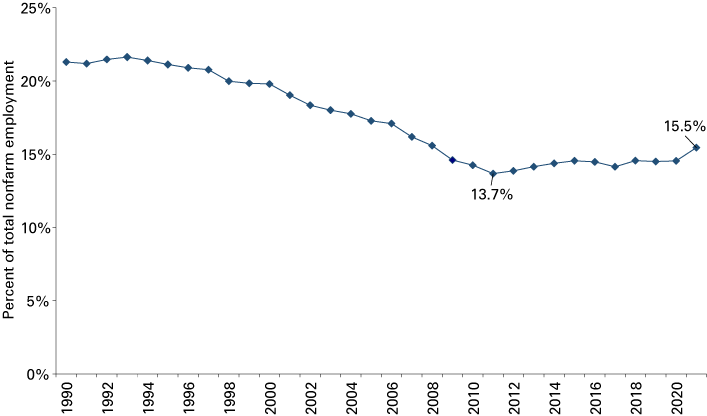Evansville forecast 2022

Professor of Economics and Provost, University of Southern Indiana
Despite ongoing labor market and supply chain disruptions since the advent of the COVID-19 pandemic in the first quarter of 2020, signs of gradual improvement in economic conditions for the Evansville metro area were evident in 2021. The unemployment rate decreased between January and September, and there has been a rebound in output and employment—highlighting a relatively short-lived COVID-19-induced economic slowdown. The economic recovery evident in the Evansville metro area during 2021 is projected to continue in 2022.
During 2021, there were announcements of capital investments amounting to $844 million and the creation of 1,529 new jobs. These include an expansion by Toyota Motor Manufacturing Indiana geared toward the introduction of new vehicle production and supplier retooling, amounting to $803 million in future capital investment and 1,400 new jobs, as well as an expansion of plastics manufacturing capacity by Berry Global through $37.6 million in future capital investment and 94 new jobs. Additional capital investments totaling $3.4 million by Moore Metal Works, Heliponix and Windstream Holdings is associated with 35 new jobs.
Once all data are released for 2021, nominal personal income is estimated to have increased by 6.5%, and real gross metro product is estimated to have increased by 6.3%. In 2022, Evansville metro area real output is forecast to increase by 4.3%, the number of jobs is projected to increase by 4,700, and nominal personal income growth is forecast to increase by 2.9%.
The unemployment rate in the Evansville metro decreased from 4.5% in January 2021 to 3.8% in September 2021. There was also a decrease in the national unemployment rate from 6.3% to 4.8% over the same period. Job gains occurred primarily in the following sectors: manufacturing; finance and insurance; professional, scientific and technical services; and accommodation and food services. The primary activities experiencing jobs losses were in mining, retail trade and government.
The manufacturing sector continues to be an important base to metro area household incomes and consumer spending activity. It exhibits an emerging resurgence with a growing share of manufacturing employment (see Figure 1).
Figure 1: Evansville metro manufacturing employment as a percent of total nonfarm employment

Note: 2021 data are for September.
Source: STATS Indiana, using U.S. Bureau of Labor Statistics and Indiana Department of Workforce Development data
As one of the most manufacturing-dependent metro areas in the nation, the Evansville economy continues to be influenced by developments in the manufacturing sector. Since the Great Recession in 2007, Evansville’s manufacturing workforce has fallen by 9% or about 2,300 workers, compared to a 2.4% reduction in Indiana’s manufacturing workforce over the same period. In 2021, the manufacturing sector witnessed an uptick in economic activity, with manufacturing’s share of total employment reaching its highest level since 2008. The manufacturing sector accounts for 23.3% of the gross regional product in the Evansville regional economy and 15.5% of employment in the Evansville metro (see Table 1).
Table 1: Manufacturing's percent of total employment, September 2021
| Evansville | Indiana | U.S. | |
|---|---|---|---|
| Manufacturing | 15.5% | 17.4% | 8.4% |
| Durables | 37.5% | 71.1% | 62.1% |
| Nondurables | 62.5% | 28.9% | 37.9% |
Source: STATS Indiana, using U.S. Bureau of Labor Statistics and
Indiana Department of Workforce Development data
Given the proportion of output that is sold outside the metro area, the economic vitality in the Evansville area is linked to the strength of the broader economy. As employment and demand for locally produced goods continue to surpass pre-pandemic levels, both employment and output are expected to increase in 2022.
A widening gap between the Evansville economy and the U.S. economy regarding growth in nondurable manufacturing highlights a differentiating characteristic in the economic structure of the Evansville economy. Strategies aimed at taking advantage of the associated industry clusters represent an added dimension for economic development initiatives in the Evansville region.



